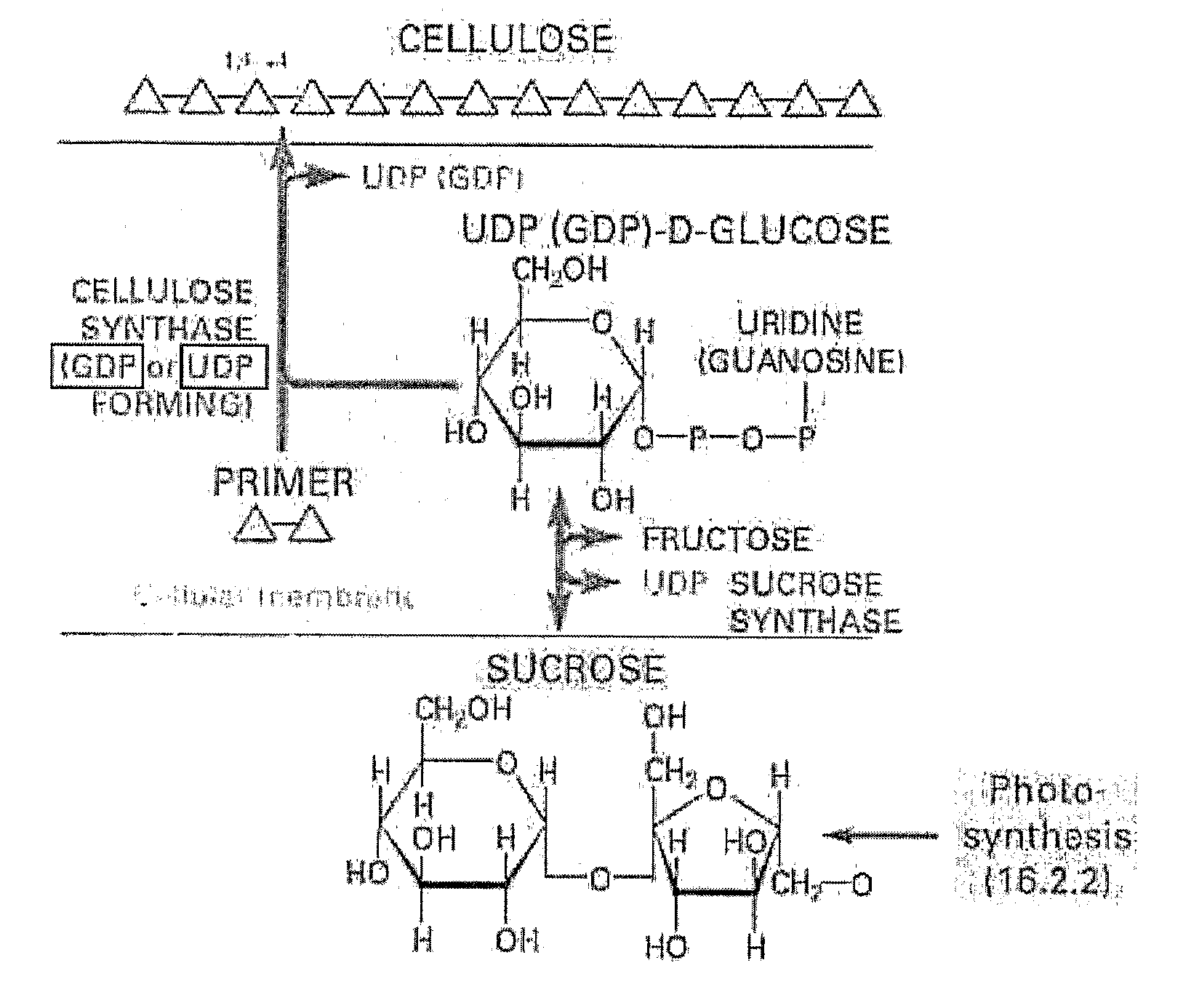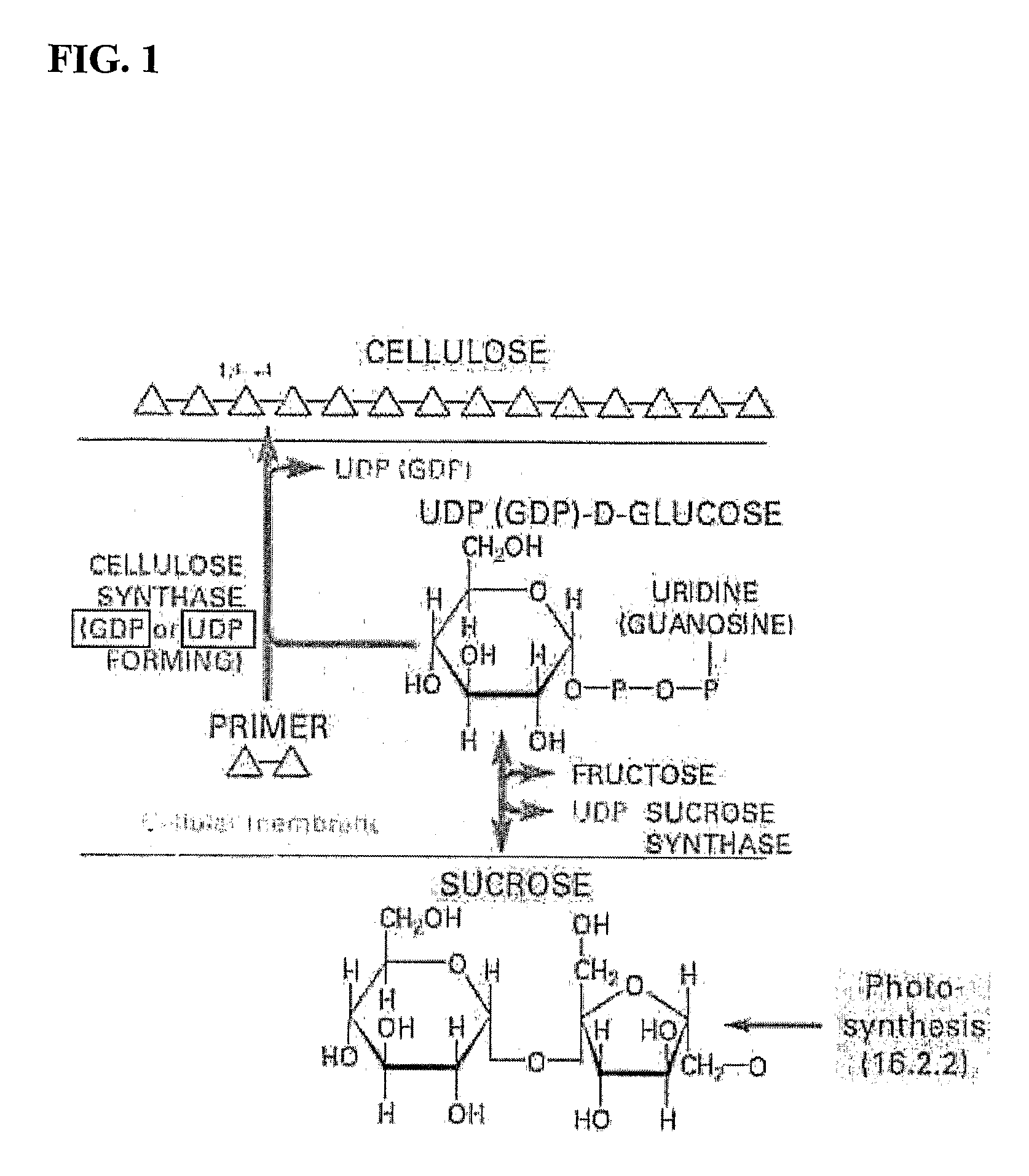Polynucleotides, DNA constructs and methods for the alteration of plant cellulose content
a technology of plant cellulose and dna, applied in the field of molecular biology and the regulation of protein synthesis, can solve the problems of inefficient sucrose partitioning between source and sink, and achieve the effects of reducing lignin content, increasing cellulose content, and reducing cellulose conten
- Summary
- Abstract
- Description
- Claims
- Application Information
AI Technical Summary
Benefits of technology
Problems solved by technology
Method used
Image
Examples
example 1
Isolation of a Sucrose Synthase DNA Sequence from Anabaena Sp. PCC 7120
(a) Genomic DNA Preparation
[0066]Anabaena sp. PCC 7120 (ATCC) was grown in BG-11 medium under constant cold fluorescent light with gentle agitation for one week or until the culture medium showed a green color. Cyanobacterial cells were pelleted and treated with 1% Triton X-100; 10 mM Tris pH 8.0; 1 mM EDTA pH 8.0 at 95° C. for 30 min. The lysate was extracted twice with CHCl3 and the resulting supernatant was used as a source of template genomic DNA for the subsequent PCR reactions.
(b) Primer Design
[0067]A DNA sequence representing the sucrose synthase gene from Anabaena variabilis ATCC 29413 has already been determined and deposited in the GenBank under accession number AJ292758. Based on this sequence, DNA oligomers were synthesized as primers for PCR, including either the region around the first codon ATG or around the termination codon of the main ORF encoding the sucrose synthase enzyme.
[0068]Primers were d...
example 2
Synthesis of a Modified Codon Usage-Adapted Sucrose Synthase DNA Sequence
[0070]Gene synthesis was performed according to the procedure described by Young & Dong, Nucl. Acid Res. 32: e59 (2004). Briefly, 50-mer oligonucleotides covering the entire length of the final DNA sequence are synthesized such that adjacent primers show a 10 bp long overlap. To synthesize a sucrose synthase gene coding for Anabaena sucrose synthase enzyme, 62 primers were designed, including oligonucleotides at both ends of the sequence to insert NdeI and XbaI sites in the final PCR product. In the first PCR round, the primers are separately mixed in primer extension reactions, such that each reaction contains four adjacent primers, including two of the adjacent primers in the preceding reaction. In the second step, four groups of 8 extension reactions each are pooled and subjected to another primer extension reaction, followed by a third PCR reaction with flanking primers to amplify four ˜800 bp DNA fragments...
example 3
Preparation of Transgenic Nicotiana Plants
[0071]The sucrose synthase genes obtained in Examples 1 and 2 above were introduced into a plant host to produce transgenic Nicotiana plants.
[0072](a) Preparation of Constructs and Transformation of Agrobacterium
[0073]Expression constructs can be prepared by cleaving the sucrose synthase genes obtained in Examples 1 and 2 above with suitable restriction enzymes so as to include all of the open reading frame and inserting the gene into the plant transformation vector pALELLYX-Susy (FIG. 2) together with an appropriate promoter. For example, the Anabaena sucrose synthase gene obtained in Example 1 was cloned into the aforementioned expression vector downstream to a xylem-preferred tubulin gene (TUB) promoter from Populus deltoides, as set forth in international application PCT / BR2005 / 000041, filed Mar. 28, 2005 (FIG. 3). Alternatively, the codon usage-adapted Anabaena sucrose synthase gene obtained in Example 2 was cloned into the aforementio...
PUM
| Property | Measurement | Unit |
|---|---|---|
| volume | aaaaa | aaaaa |
| nucleic acid | aaaaa | aaaaa |
| mechanical strength | aaaaa | aaaaa |
Abstract
Description
Claims
Application Information
 Login to View More
Login to View More - R&D
- Intellectual Property
- Life Sciences
- Materials
- Tech Scout
- Unparalleled Data Quality
- Higher Quality Content
- 60% Fewer Hallucinations
Browse by: Latest US Patents, China's latest patents, Technical Efficacy Thesaurus, Application Domain, Technology Topic, Popular Technical Reports.
© 2025 PatSnap. All rights reserved.Legal|Privacy policy|Modern Slavery Act Transparency Statement|Sitemap|About US| Contact US: help@patsnap.com



